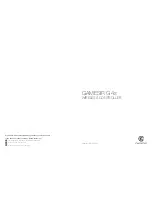
EN
Page 18/44
2.16 EMISSION OF HARMFUL GASES AND VAPOURS
•
When safety equipment is open, or in case of malfunctions, harmful gases can scape(see
above). Ensure suffi cient ventilation or extraction.
•
Take special precautionary measures with dangerous media. In particular, lead off relief
valve and purge valve via rigid pipework and dispose of the substances in a safety-
conscious and environmentally responsible manner.
2.17 SERVICING AND MAINTENANCE, RECTIFICATION
OF MALFUNCTIONS
•
Have prescribed setting, servicing and inspection work carried out punctually by the
manufacturer or by a specialist fi rm authorized by the manufacturer.
•
Inform operating personnel and users before servicing and maintenance work starts.
•
All upstream and downstream equipment required for controlling the pressure devices
and/or the system, such as compressed air and hydraulic systems, must be secured
against unauthorized start-up.
•
Before all servicing, maintenance and repair work, the associated equipment must be
switched off electrically.
•
The main switch must be secured against unauthorized start-up.
•
Lock the main switch and remove the key.
•
Attach a warning sign to prevent it being switched on.
•
Check tightness of screwed connections which were released.
•
Check function of safety equipment after completion of servicing work.
2.18 CONSTRUCTIONAL ALTERATIONS TO THE PRESSURE DEVICE
OR THE SYSTEM
•
Do not make changes, additions or alterations to the pressure device without written
approval from the manufacturer.
•
Parts of the system which are not in perfect working order must be replaced immediately.
•
Use only original spare parts and wearing parts of the manufacturer.
2.19 CLEANING PRESSURE DEVICES AND DISPOSING
OF RESIDUES
•
Pressure devices which have been used and are awaiting repair must be purged with an
inert gas (nitrogen, argon). Solid gas residues must be handled and disposed of correctly.
In particular, do not contaminate with oily rags or lubricants. Do not clean with solvents.
2.20 NOISE GENERATION
In some cases noise generation can result from an unfavourable combination of particular
parameters, e.g. fl ow rate and pressure range, but also gas type. In such cases please
contact the manufacturer.
2.21 LAWS, DIRECTIVES, NORMS, REGULATIONS
2.21.1 LAWS AND REGULATIONS
•
GSG Device security law with aVV General administrative regulations to the GSG,
6. GSGV pressure vessel regulations, 7. GSGV Regulation on gas consumption facilities
and GasHL-VO Regulation on high pressure pipe lines.
•
ChemG Law for use of chemical substances with corresponding GefStoffV Regulations on
dangerous substances and ArbstoffV Law concerning technical working materials.
•
AcetV Acetylen regulations
•
BImSchG Law for protection against neighbouring effects of gases, smoke noise, smells
etc. with BImSchV FCKW-Halon-Prohibition-Regulation and 2. BImSchV Emission
Limitation of volatile Halogenated Hydrocarbons
•
Technical Norms, Regulations to Accident Prevention
















































